Organisational Behaviour Report: Analysing Organisational Behaviour
VerifiedAdded on 2022/12/28
|18
|4940
|33
Report
AI Summary
This report on organisational behaviour delves into the dynamics within Robert Welch, a company that designs and manufactures cutlery sets. It examines the influence of organisational culture, politics, and power on individual and team behaviour and performance, analysing how these factors intertwine to affect employee outcomes. The report then evaluates content and process theories of motivation, including Maslow's hierarchy of needs, Herzberg's two-factor theory, Vroom's expectancy theory, and Adams' equity theory, to assess their effectiveness in achieving organisational goals. Furthermore, it compares the characteristics of effective and ineffective teams, highlighting the importance of team dynamics. Finally, the report explores different concepts and philosophies of organisational behaviour, emphasizing the significance of cultural awareness and emotional intelligence in leadership and team management. The report underscores the importance of understanding and managing these aspects to improve organisational performance and employee satisfaction.
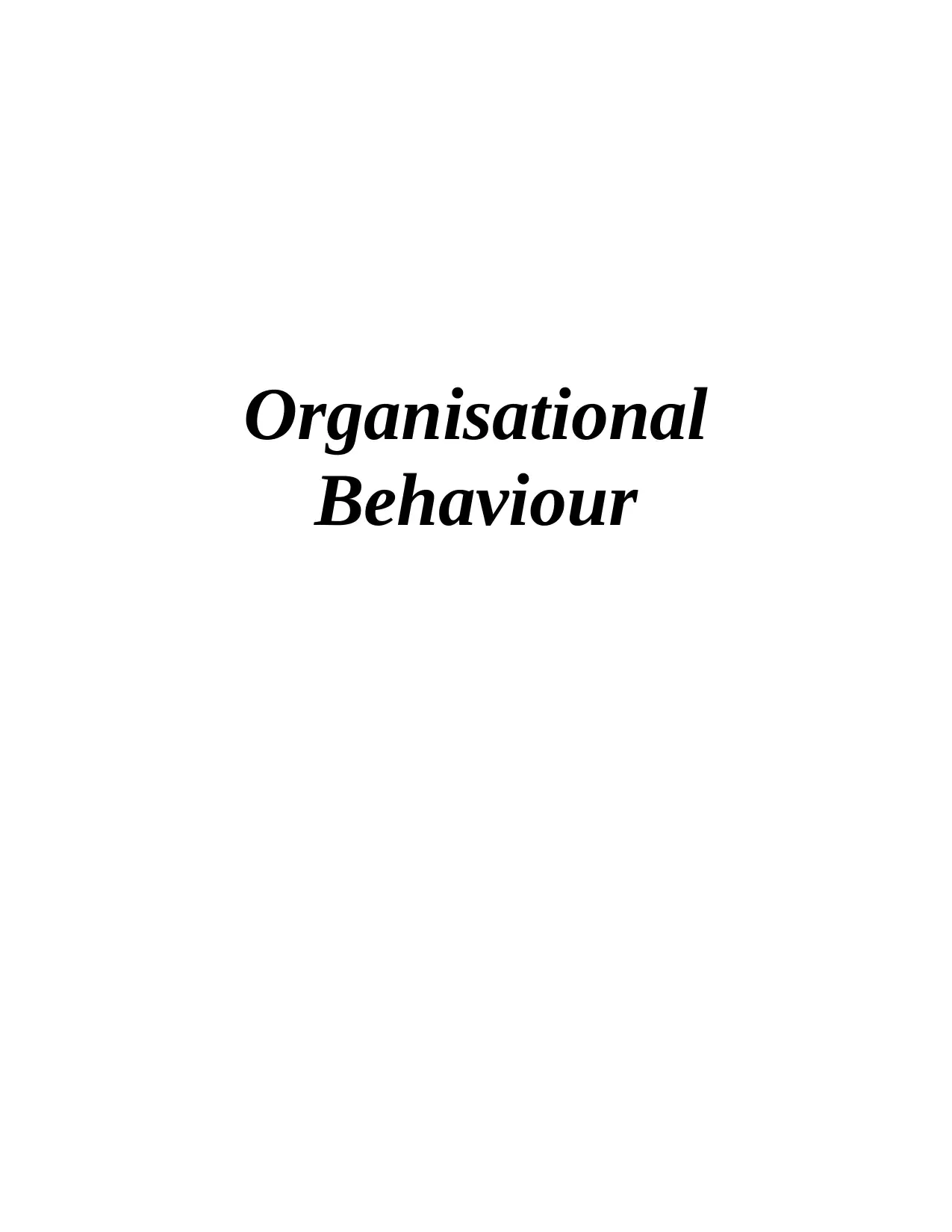
Organisational
Behaviour
Behaviour
Paraphrase This Document
Need a fresh take? Get an instant paraphrase of this document with our AI Paraphraser
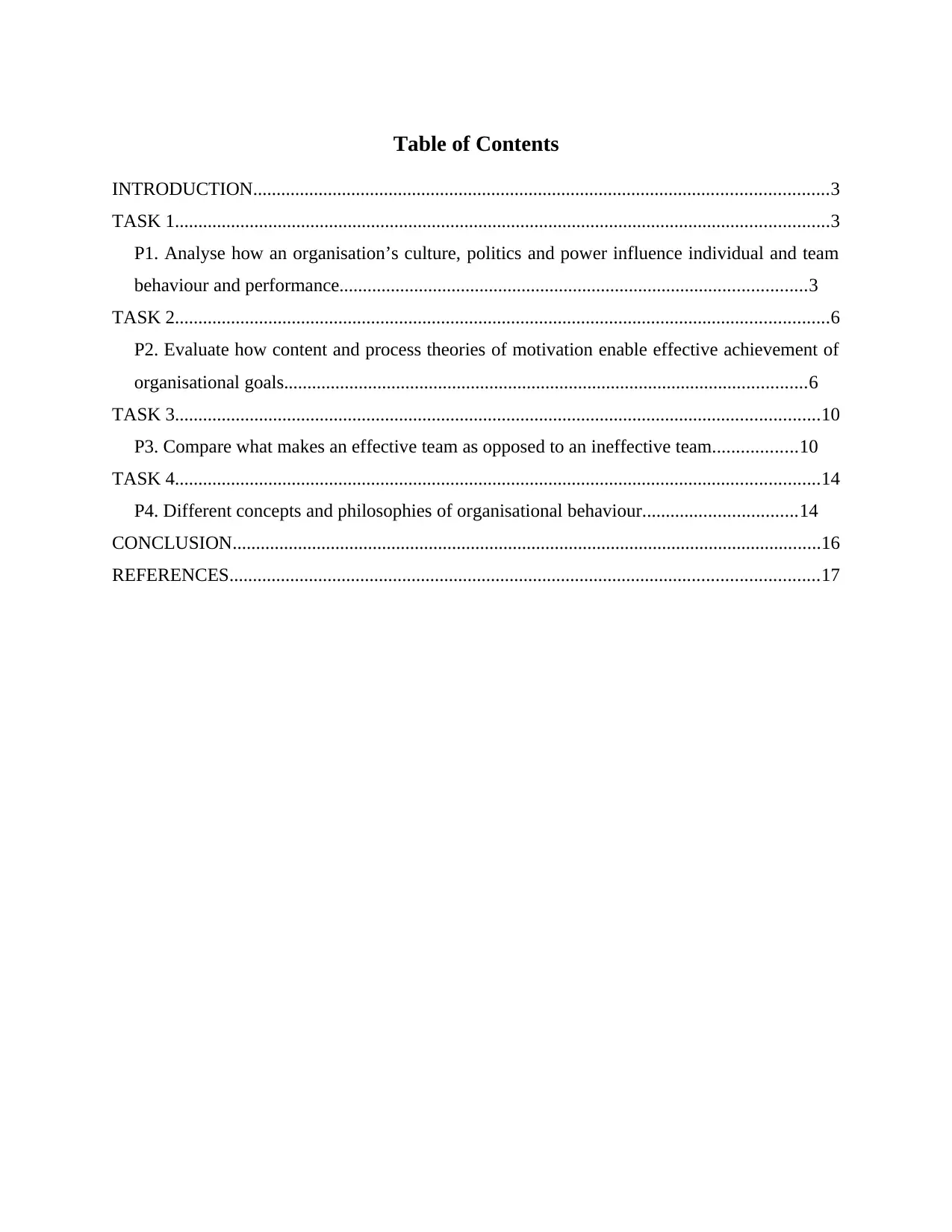
Table of Contents
INTRODUCTION...........................................................................................................................3
TASK 1............................................................................................................................................3
P1. Analyse how an organisation’s culture, politics and power influence individual and team
behaviour and performance....................................................................................................3
TASK 2............................................................................................................................................6
P2. Evaluate how content and process theories of motivation enable effective achievement of
organisational goals................................................................................................................6
TASK 3..........................................................................................................................................10
P3. Compare what makes an effective team as opposed to an ineffective team..................10
TASK 4..........................................................................................................................................14
P4. Different concepts and philosophies of organisational behaviour.................................14
CONCLUSION..............................................................................................................................16
REFERENCES..............................................................................................................................17
INTRODUCTION...........................................................................................................................3
TASK 1............................................................................................................................................3
P1. Analyse how an organisation’s culture, politics and power influence individual and team
behaviour and performance....................................................................................................3
TASK 2............................................................................................................................................6
P2. Evaluate how content and process theories of motivation enable effective achievement of
organisational goals................................................................................................................6
TASK 3..........................................................................................................................................10
P3. Compare what makes an effective team as opposed to an ineffective team..................10
TASK 4..........................................................................................................................................14
P4. Different concepts and philosophies of organisational behaviour.................................14
CONCLUSION..............................................................................................................................16
REFERENCES..............................................................................................................................17
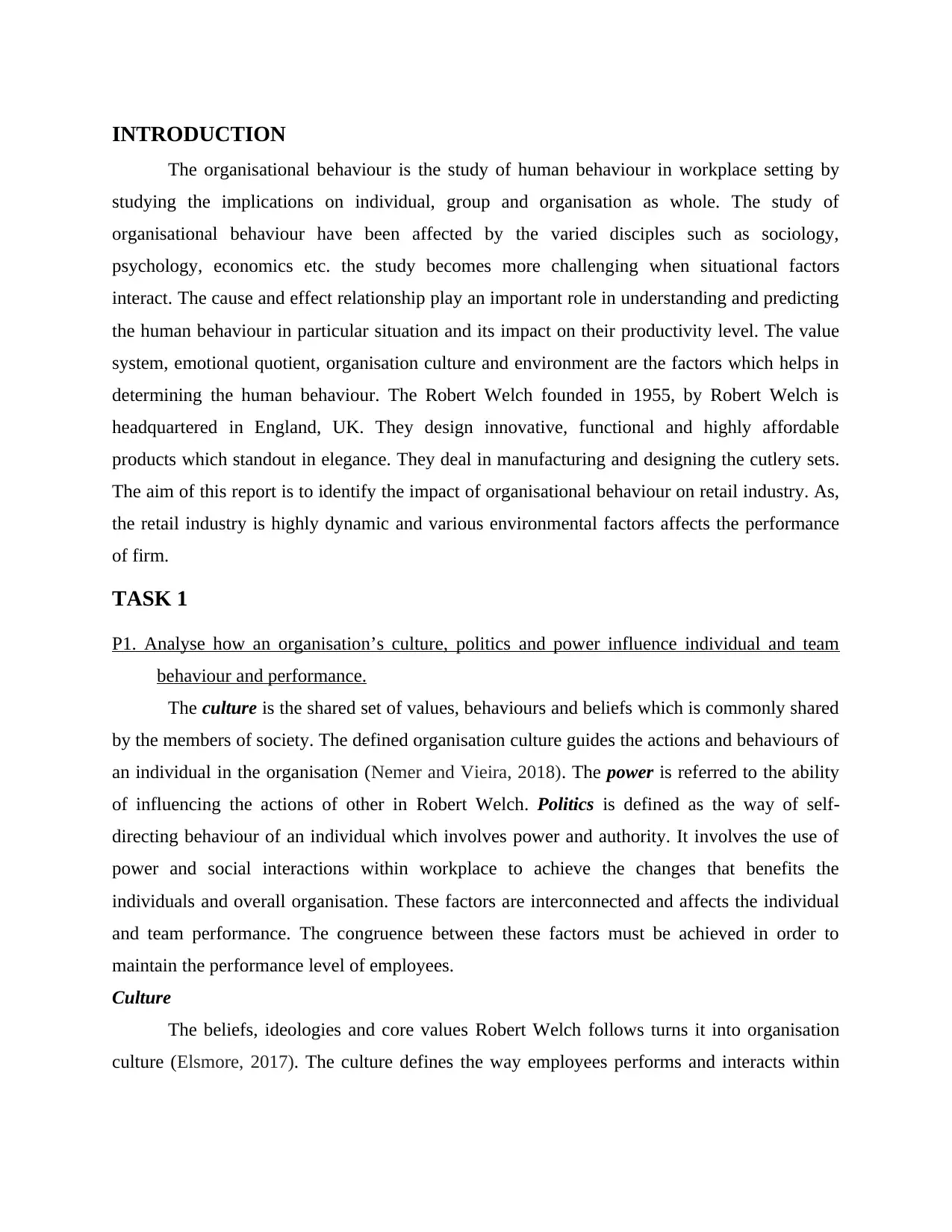
INTRODUCTION
The organisational behaviour is the study of human behaviour in workplace setting by
studying the implications on individual, group and organisation as whole. The study of
organisational behaviour have been affected by the varied disciples such as sociology,
psychology, economics etc. the study becomes more challenging when situational factors
interact. The cause and effect relationship play an important role in understanding and predicting
the human behaviour in particular situation and its impact on their productivity level. The value
system, emotional quotient, organisation culture and environment are the factors which helps in
determining the human behaviour. The Robert Welch founded in 1955, by Robert Welch is
headquartered in England, UK. They design innovative, functional and highly affordable
products which standout in elegance. They deal in manufacturing and designing the cutlery sets.
The aim of this report is to identify the impact of organisational behaviour on retail industry. As,
the retail industry is highly dynamic and various environmental factors affects the performance
of firm.
TASK 1
P1. Analyse how an organisation’s culture, politics and power influence individual and team
behaviour and performance.
The culture is the shared set of values, behaviours and beliefs which is commonly shared
by the members of society. The defined organisation culture guides the actions and behaviours of
an individual in the organisation (Nemer and Vieira, 2018). The power is referred to the ability
of influencing the actions of other in Robert Welch. Politics is defined as the way of self-
directing behaviour of an individual which involves power and authority. It involves the use of
power and social interactions within workplace to achieve the changes that benefits the
individuals and overall organisation. These factors are interconnected and affects the individual
and team performance. The congruence between these factors must be achieved in order to
maintain the performance level of employees.
Culture
The beliefs, ideologies and core values Robert Welch follows turns it into organisation
culture (Elsmore, 2017). The culture defines the way employees performs and interacts within
The organisational behaviour is the study of human behaviour in workplace setting by
studying the implications on individual, group and organisation as whole. The study of
organisational behaviour have been affected by the varied disciples such as sociology,
psychology, economics etc. the study becomes more challenging when situational factors
interact. The cause and effect relationship play an important role in understanding and predicting
the human behaviour in particular situation and its impact on their productivity level. The value
system, emotional quotient, organisation culture and environment are the factors which helps in
determining the human behaviour. The Robert Welch founded in 1955, by Robert Welch is
headquartered in England, UK. They design innovative, functional and highly affordable
products which standout in elegance. They deal in manufacturing and designing the cutlery sets.
The aim of this report is to identify the impact of organisational behaviour on retail industry. As,
the retail industry is highly dynamic and various environmental factors affects the performance
of firm.
TASK 1
P1. Analyse how an organisation’s culture, politics and power influence individual and team
behaviour and performance.
The culture is the shared set of values, behaviours and beliefs which is commonly shared
by the members of society. The defined organisation culture guides the actions and behaviours of
an individual in the organisation (Nemer and Vieira, 2018). The power is referred to the ability
of influencing the actions of other in Robert Welch. Politics is defined as the way of self-
directing behaviour of an individual which involves power and authority. It involves the use of
power and social interactions within workplace to achieve the changes that benefits the
individuals and overall organisation. These factors are interconnected and affects the individual
and team performance. The congruence between these factors must be achieved in order to
maintain the performance level of employees.
Culture
The beliefs, ideologies and core values Robert Welch follows turns it into organisation
culture (Elsmore, 2017). The culture defines the way employees performs and interacts within
⊘ This is a preview!⊘
Do you want full access?
Subscribe today to unlock all pages.

Trusted by 1+ million students worldwide
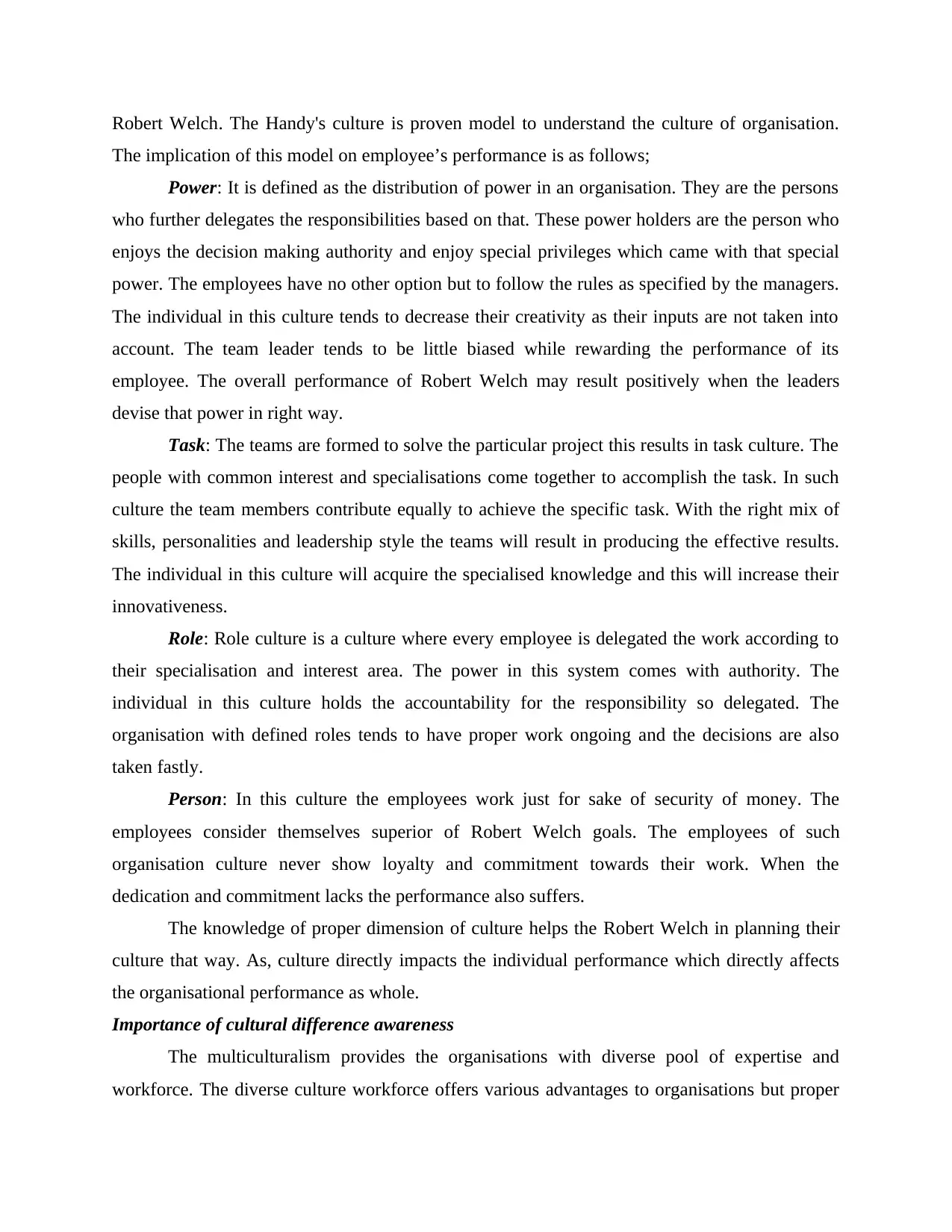
Robert Welch. The Handy's culture is proven model to understand the culture of organisation.
The implication of this model on employee’s performance is as follows;
Power: It is defined as the distribution of power in an organisation. They are the persons
who further delegates the responsibilities based on that. These power holders are the person who
enjoys the decision making authority and enjoy special privileges which came with that special
power. The employees have no other option but to follow the rules as specified by the managers.
The individual in this culture tends to decrease their creativity as their inputs are not taken into
account. The team leader tends to be little biased while rewarding the performance of its
employee. The overall performance of Robert Welch may result positively when the leaders
devise that power in right way.
Task: The teams are formed to solve the particular project this results in task culture. The
people with common interest and specialisations come together to accomplish the task. In such
culture the team members contribute equally to achieve the specific task. With the right mix of
skills, personalities and leadership style the teams will result in producing the effective results.
The individual in this culture will acquire the specialised knowledge and this will increase their
innovativeness.
Role: Role culture is a culture where every employee is delegated the work according to
their specialisation and interest area. The power in this system comes with authority. The
individual in this culture holds the accountability for the responsibility so delegated. The
organisation with defined roles tends to have proper work ongoing and the decisions are also
taken fastly.
Person: In this culture the employees work just for sake of security of money. The
employees consider themselves superior of Robert Welch goals. The employees of such
organisation culture never show loyalty and commitment towards their work. When the
dedication and commitment lacks the performance also suffers.
The knowledge of proper dimension of culture helps the Robert Welch in planning their
culture that way. As, culture directly impacts the individual performance which directly affects
the organisational performance as whole.
Importance of cultural difference awareness
The multiculturalism provides the organisations with diverse pool of expertise and
workforce. The diverse culture workforce offers various advantages to organisations but proper
The implication of this model on employee’s performance is as follows;
Power: It is defined as the distribution of power in an organisation. They are the persons
who further delegates the responsibilities based on that. These power holders are the person who
enjoys the decision making authority and enjoy special privileges which came with that special
power. The employees have no other option but to follow the rules as specified by the managers.
The individual in this culture tends to decrease their creativity as their inputs are not taken into
account. The team leader tends to be little biased while rewarding the performance of its
employee. The overall performance of Robert Welch may result positively when the leaders
devise that power in right way.
Task: The teams are formed to solve the particular project this results in task culture. The
people with common interest and specialisations come together to accomplish the task. In such
culture the team members contribute equally to achieve the specific task. With the right mix of
skills, personalities and leadership style the teams will result in producing the effective results.
The individual in this culture will acquire the specialised knowledge and this will increase their
innovativeness.
Role: Role culture is a culture where every employee is delegated the work according to
their specialisation and interest area. The power in this system comes with authority. The
individual in this culture holds the accountability for the responsibility so delegated. The
organisation with defined roles tends to have proper work ongoing and the decisions are also
taken fastly.
Person: In this culture the employees work just for sake of security of money. The
employees consider themselves superior of Robert Welch goals. The employees of such
organisation culture never show loyalty and commitment towards their work. When the
dedication and commitment lacks the performance also suffers.
The knowledge of proper dimension of culture helps the Robert Welch in planning their
culture that way. As, culture directly impacts the individual performance which directly affects
the organisational performance as whole.
Importance of cultural difference awareness
The multiculturalism provides the organisations with diverse pool of expertise and
workforce. The diverse culture workforce offers various advantages to organisations but proper
Paraphrase This Document
Need a fresh take? Get an instant paraphrase of this document with our AI Paraphraser
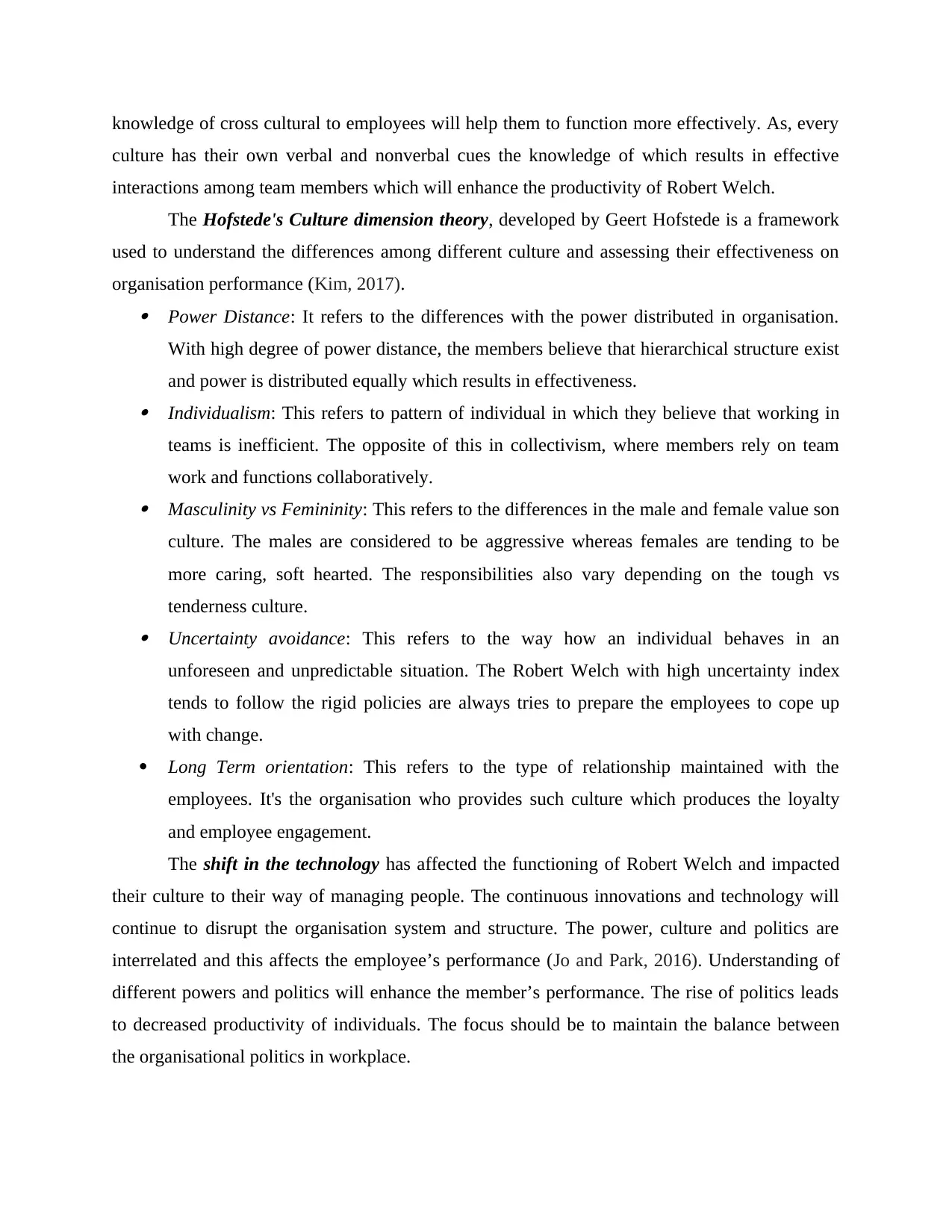
knowledge of cross cultural to employees will help them to function more effectively. As, every
culture has their own verbal and nonverbal cues the knowledge of which results in effective
interactions among team members which will enhance the productivity of Robert Welch.
The Hofstede's Culture dimension theory, developed by Geert Hofstede is a framework
used to understand the differences among different culture and assessing their effectiveness on
organisation performance (Kim, 2017). Power Distance: It refers to the differences with the power distributed in organisation.
With high degree of power distance, the members believe that hierarchical structure exist
and power is distributed equally which results in effectiveness. Individualism: This refers to pattern of individual in which they believe that working in
teams is inefficient. The opposite of this in collectivism, where members rely on team
work and functions collaboratively. Masculinity vs Femininity: This refers to the differences in the male and female value son
culture. The males are considered to be aggressive whereas females are tending to be
more caring, soft hearted. The responsibilities also vary depending on the tough vs
tenderness culture. Uncertainty avoidance: This refers to the way how an individual behaves in an
unforeseen and unpredictable situation. The Robert Welch with high uncertainty index
tends to follow the rigid policies are always tries to prepare the employees to cope up
with change.
Long Term orientation: This refers to the type of relationship maintained with the
employees. It's the organisation who provides such culture which produces the loyalty
and employee engagement.
The shift in the technology has affected the functioning of Robert Welch and impacted
their culture to their way of managing people. The continuous innovations and technology will
continue to disrupt the organisation system and structure. The power, culture and politics are
interrelated and this affects the employee’s performance (Jo and Park, 2016). Understanding of
different powers and politics will enhance the member’s performance. The rise of politics leads
to decreased productivity of individuals. The focus should be to maintain the balance between
the organisational politics in workplace.
culture has their own verbal and nonverbal cues the knowledge of which results in effective
interactions among team members which will enhance the productivity of Robert Welch.
The Hofstede's Culture dimension theory, developed by Geert Hofstede is a framework
used to understand the differences among different culture and assessing their effectiveness on
organisation performance (Kim, 2017). Power Distance: It refers to the differences with the power distributed in organisation.
With high degree of power distance, the members believe that hierarchical structure exist
and power is distributed equally which results in effectiveness. Individualism: This refers to pattern of individual in which they believe that working in
teams is inefficient. The opposite of this in collectivism, where members rely on team
work and functions collaboratively. Masculinity vs Femininity: This refers to the differences in the male and female value son
culture. The males are considered to be aggressive whereas females are tending to be
more caring, soft hearted. The responsibilities also vary depending on the tough vs
tenderness culture. Uncertainty avoidance: This refers to the way how an individual behaves in an
unforeseen and unpredictable situation. The Robert Welch with high uncertainty index
tends to follow the rigid policies are always tries to prepare the employees to cope up
with change.
Long Term orientation: This refers to the type of relationship maintained with the
employees. It's the organisation who provides such culture which produces the loyalty
and employee engagement.
The shift in the technology has affected the functioning of Robert Welch and impacted
their culture to their way of managing people. The continuous innovations and technology will
continue to disrupt the organisation system and structure. The power, culture and politics are
interrelated and this affects the employee’s performance (Jo and Park, 2016). Understanding of
different powers and politics will enhance the member’s performance. The rise of politics leads
to decreased productivity of individuals. The focus should be to maintain the balance between
the organisational politics in workplace.
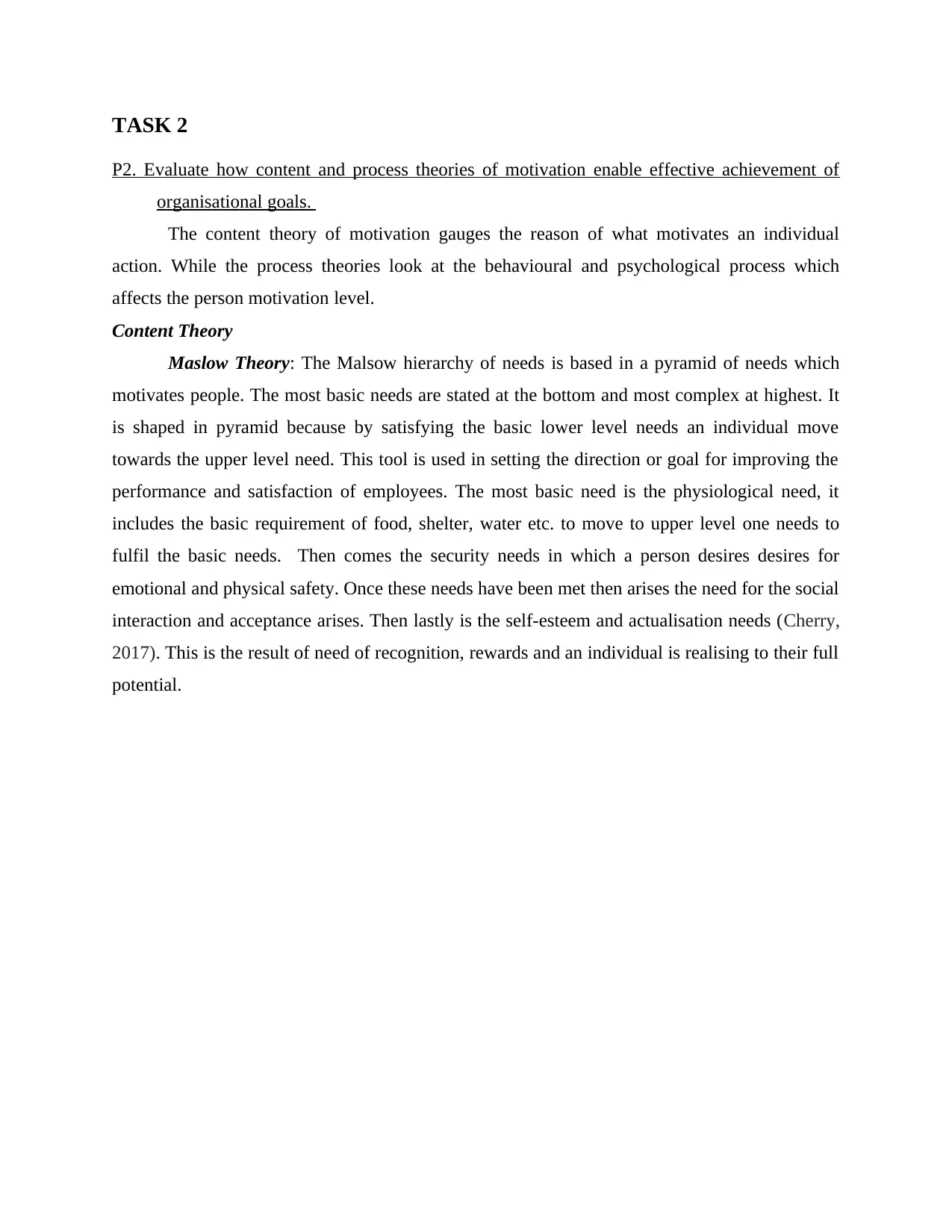
TASK 2
P2. Evaluate how content and process theories of motivation enable effective achievement of
organisational goals.
The content theory of motivation gauges the reason of what motivates an individual
action. While the process theories look at the behavioural and psychological process which
affects the person motivation level.
Content Theory
Maslow Theory: The Malsow hierarchy of needs is based in a pyramid of needs which
motivates people. The most basic needs are stated at the bottom and most complex at highest. It
is shaped in pyramid because by satisfying the basic lower level needs an individual move
towards the upper level need. This tool is used in setting the direction or goal for improving the
performance and satisfaction of employees. The most basic need is the physiological need, it
includes the basic requirement of food, shelter, water etc. to move to upper level one needs to
fulfil the basic needs. Then comes the security needs in which a person desires desires for
emotional and physical safety. Once these needs have been met then arises the need for the social
interaction and acceptance arises. Then lastly is the self-esteem and actualisation needs (Cherry,
2017). This is the result of need of recognition, rewards and an individual is realising to their full
potential.
P2. Evaluate how content and process theories of motivation enable effective achievement of
organisational goals.
The content theory of motivation gauges the reason of what motivates an individual
action. While the process theories look at the behavioural and psychological process which
affects the person motivation level.
Content Theory
Maslow Theory: The Malsow hierarchy of needs is based in a pyramid of needs which
motivates people. The most basic needs are stated at the bottom and most complex at highest. It
is shaped in pyramid because by satisfying the basic lower level needs an individual move
towards the upper level need. This tool is used in setting the direction or goal for improving the
performance and satisfaction of employees. The most basic need is the physiological need, it
includes the basic requirement of food, shelter, water etc. to move to upper level one needs to
fulfil the basic needs. Then comes the security needs in which a person desires desires for
emotional and physical safety. Once these needs have been met then arises the need for the social
interaction and acceptance arises. Then lastly is the self-esteem and actualisation needs (Cherry,
2017). This is the result of need of recognition, rewards and an individual is realising to their full
potential.
⊘ This is a preview!⊘
Do you want full access?
Subscribe today to unlock all pages.

Trusted by 1+ million students worldwide

Illustration 1: Maslow's Hierarchy of Needs, 2020
Herzberg's two factor theory: The Herzberg uses two factors namely motivating factor
and hygiene factors and believes these two factors creates the dissatisfaction and satisfaction in
work . The motivating factors are the factors whose presence makes an individual satisfied at
work which includes recognition, achievement and promotions etc. at workplace. The hygiene
factors are termed as whose absence makes the person dissatisfied at workplace which includes
salary, safety working environment etc. The core point of these two factors is that necessary to
make an employee satisfied at workplace.
Once an individual has met the hygiene factors than an individual will start feeling
motivated and will achieve the higher level of performance as a result of motivating factor.
Herzberg's two factor theory: The Herzberg uses two factors namely motivating factor
and hygiene factors and believes these two factors creates the dissatisfaction and satisfaction in
work . The motivating factors are the factors whose presence makes an individual satisfied at
work which includes recognition, achievement and promotions etc. at workplace. The hygiene
factors are termed as whose absence makes the person dissatisfied at workplace which includes
salary, safety working environment etc. The core point of these two factors is that necessary to
make an employee satisfied at workplace.
Once an individual has met the hygiene factors than an individual will start feeling
motivated and will achieve the higher level of performance as a result of motivating factor.
Paraphrase This Document
Need a fresh take? Get an instant paraphrase of this document with our AI Paraphraser

Illustration 2: Herzberg’s Two Factor Theory of Motivation, 2021
Process Theory
Vroom's expectancy theory theory of motivation says that individuals are tends to be
motivated to perform some thing with the help of three things. Individuals get motivated when
reward associated with action have some value. And have trust that if they perform well in job
than they will get the reward, also develops feeling that they can easily achieve the objectives
with their hard work as they have the ability to fulfil the targets. To serve this purpose two types
of rewards such as extrinsic and intrinsic are given. Intrinsic motivation covers internal things
like sense of achievement & fulfilment. On the other hand extrinsic motivation includes external
things for example, promotion and money. As Vroom's model says that motivation level of
people is product of many factors such as valence, expectancy and instrumentality. Valence
shows that how much people value for the reward which was given to them as it its observe
through specific behaviour or results (Baumhof and et. al., 2017). Expectancy shows that how
much they tends to believe that by putting additional efforts objectives of the company can easily
be achieve. Instrumentality reflects that how much individuals believe the rewards that actually
appears ,is they able to achieve desired behaviours. If any of these factors skip than there is lack
of motivation in individuals.
Process Theory
Vroom's expectancy theory theory of motivation says that individuals are tends to be
motivated to perform some thing with the help of three things. Individuals get motivated when
reward associated with action have some value. And have trust that if they perform well in job
than they will get the reward, also develops feeling that they can easily achieve the objectives
with their hard work as they have the ability to fulfil the targets. To serve this purpose two types
of rewards such as extrinsic and intrinsic are given. Intrinsic motivation covers internal things
like sense of achievement & fulfilment. On the other hand extrinsic motivation includes external
things for example, promotion and money. As Vroom's model says that motivation level of
people is product of many factors such as valence, expectancy and instrumentality. Valence
shows that how much people value for the reward which was given to them as it its observe
through specific behaviour or results (Baumhof and et. al., 2017). Expectancy shows that how
much they tends to believe that by putting additional efforts objectives of the company can easily
be achieve. Instrumentality reflects that how much individuals believe the rewards that actually
appears ,is they able to achieve desired behaviours. If any of these factors skip than there is lack
of motivation in individuals.
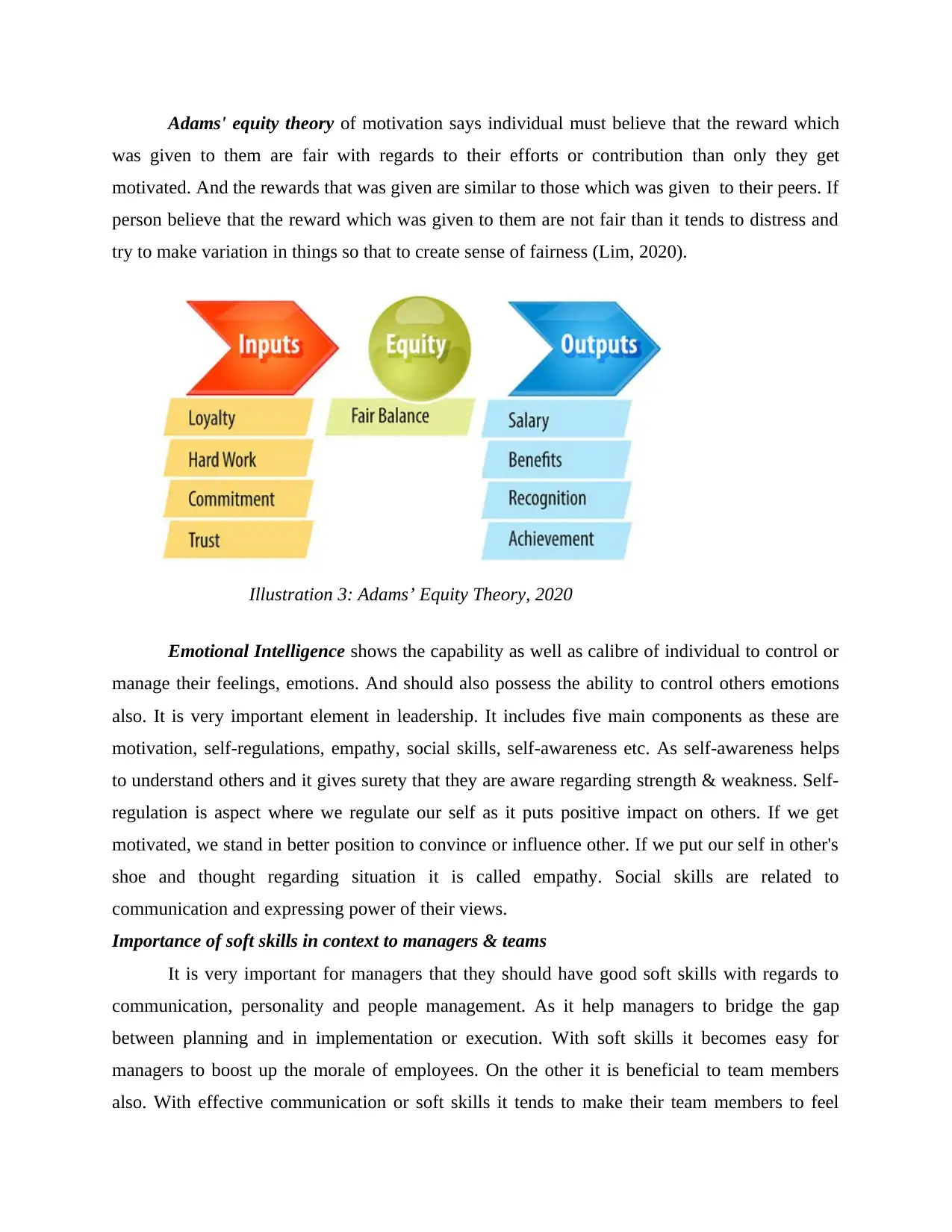
Adams' equity theory of motivation says individual must believe that the reward which
was given to them are fair with regards to their efforts or contribution than only they get
motivated. And the rewards that was given are similar to those which was given to their peers. If
person believe that the reward which was given to them are not fair than it tends to distress and
try to make variation in things so that to create sense of fairness (Lim, 2020).
Illustration 3: Adams’ Equity Theory, 2020
Emotional Intelligence shows the capability as well as calibre of individual to control or
manage their feelings, emotions. And should also possess the ability to control others emotions
also. It is very important element in leadership. It includes five main components as these are
motivation, self-regulations, empathy, social skills, self-awareness etc. As self-awareness helps
to understand others and it gives surety that they are aware regarding strength & weakness. Self-
regulation is aspect where we regulate our self as it puts positive impact on others. If we get
motivated, we stand in better position to convince or influence other. If we put our self in other's
shoe and thought regarding situation it is called empathy. Social skills are related to
communication and expressing power of their views.
Importance of soft skills in context to managers & teams
It is very important for managers that they should have good soft skills with regards to
communication, personality and people management. As it help managers to bridge the gap
between planning and in implementation or execution. With soft skills it becomes easy for
managers to boost up the morale of employees. On the other it is beneficial to team members
also. With effective communication or soft skills it tends to make their team members to feel
was given to them are fair with regards to their efforts or contribution than only they get
motivated. And the rewards that was given are similar to those which was given to their peers. If
person believe that the reward which was given to them are not fair than it tends to distress and
try to make variation in things so that to create sense of fairness (Lim, 2020).
Illustration 3: Adams’ Equity Theory, 2020
Emotional Intelligence shows the capability as well as calibre of individual to control or
manage their feelings, emotions. And should also possess the ability to control others emotions
also. It is very important element in leadership. It includes five main components as these are
motivation, self-regulations, empathy, social skills, self-awareness etc. As self-awareness helps
to understand others and it gives surety that they are aware regarding strength & weakness. Self-
regulation is aspect where we regulate our self as it puts positive impact on others. If we get
motivated, we stand in better position to convince or influence other. If we put our self in other's
shoe and thought regarding situation it is called empathy. Social skills are related to
communication and expressing power of their views.
Importance of soft skills in context to managers & teams
It is very important for managers that they should have good soft skills with regards to
communication, personality and people management. As it help managers to bridge the gap
between planning and in implementation or execution. With soft skills it becomes easy for
managers to boost up the morale of employees. On the other it is beneficial to team members
also. With effective communication or soft skills it tends to make their team members to feel
⊘ This is a preview!⊘
Do you want full access?
Subscribe today to unlock all pages.

Trusted by 1+ million students worldwide
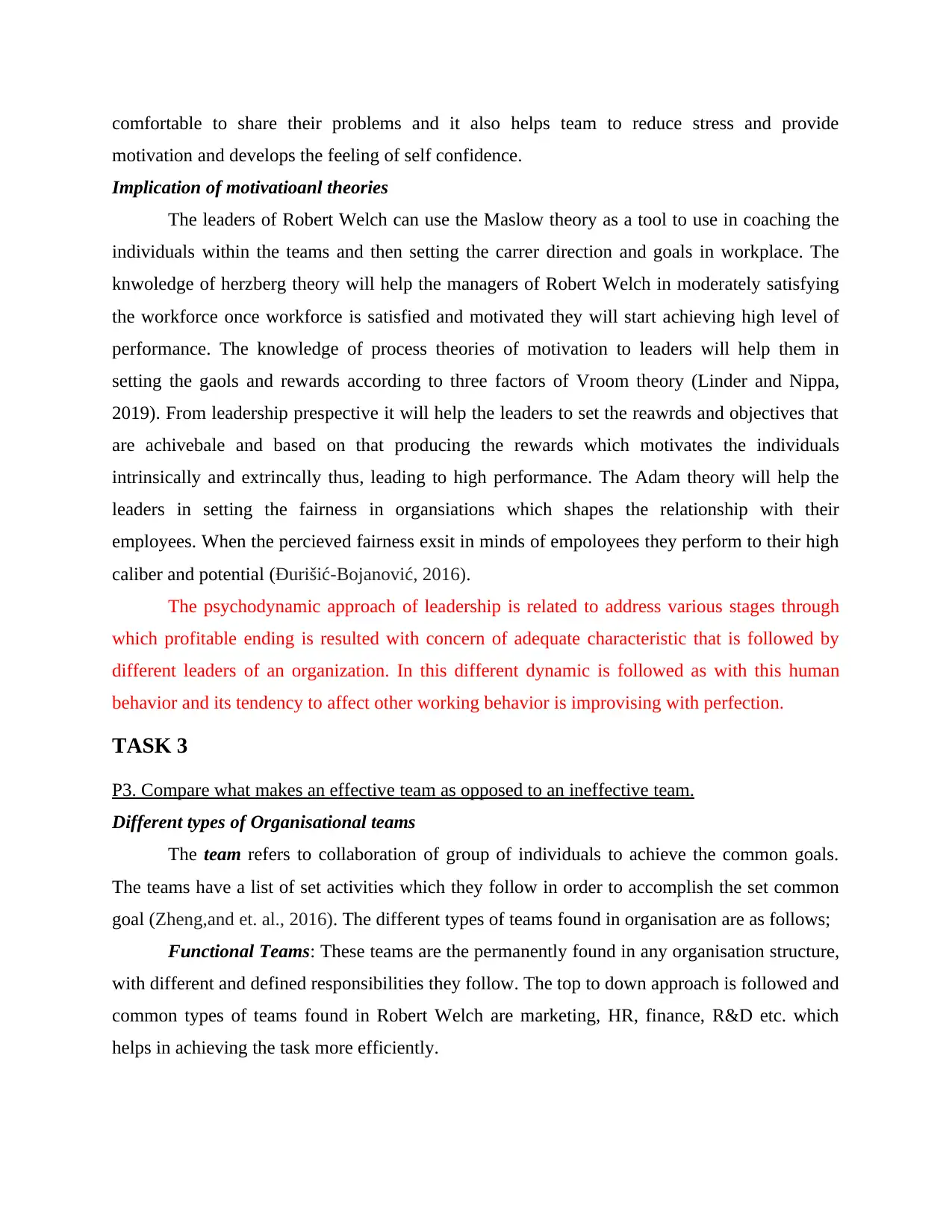
comfortable to share their problems and it also helps team to reduce stress and provide
motivation and develops the feeling of self confidence.
Implication of motivatioanl theories
The leaders of Robert Welch can use the Maslow theory as a tool to use in coaching the
individuals within the teams and then setting the carrer direction and goals in workplace. The
knwoledge of herzberg theory will help the managers of Robert Welch in moderately satisfying
the workforce once workforce is satisfied and motivated they will start achieving high level of
performance. The knowledge of process theories of motivation to leaders will help them in
setting the gaols and rewards according to three factors of Vroom theory (Linder and Nippa,
2019). From leadership prespective it will help the leaders to set the reawrds and objectives that
are achivebale and based on that producing the rewards which motivates the individuals
intrinsically and extrincally thus, leading to high performance. The Adam theory will help the
leaders in setting the fairness in organsiations which shapes the relationship with their
employees. When the percieved fairness exsit in minds of empoloyees they perform to their high
caliber and potential (Đurišić-Bojanović, 2016).
The psychodynamic approach of leadership is related to address various stages through
which profitable ending is resulted with concern of adequate characteristic that is followed by
different leaders of an organization. In this different dynamic is followed as with this human
behavior and its tendency to affect other working behavior is improvising with perfection.
TASK 3
P3. Compare what makes an effective team as opposed to an ineffective team.
Different types of Organisational teams
The team refers to collaboration of group of individuals to achieve the common goals.
The teams have a list of set activities which they follow in order to accomplish the set common
goal (Zheng,and et. al., 2016). The different types of teams found in organisation are as follows;
Functional Teams: These teams are the permanently found in any organisation structure,
with different and defined responsibilities they follow. The top to down approach is followed and
common types of teams found in Robert Welch are marketing, HR, finance, R&D etc. which
helps in achieving the task more efficiently.
motivation and develops the feeling of self confidence.
Implication of motivatioanl theories
The leaders of Robert Welch can use the Maslow theory as a tool to use in coaching the
individuals within the teams and then setting the carrer direction and goals in workplace. The
knwoledge of herzberg theory will help the managers of Robert Welch in moderately satisfying
the workforce once workforce is satisfied and motivated they will start achieving high level of
performance. The knowledge of process theories of motivation to leaders will help them in
setting the gaols and rewards according to three factors of Vroom theory (Linder and Nippa,
2019). From leadership prespective it will help the leaders to set the reawrds and objectives that
are achivebale and based on that producing the rewards which motivates the individuals
intrinsically and extrincally thus, leading to high performance. The Adam theory will help the
leaders in setting the fairness in organsiations which shapes the relationship with their
employees. When the percieved fairness exsit in minds of empoloyees they perform to their high
caliber and potential (Đurišić-Bojanović, 2016).
The psychodynamic approach of leadership is related to address various stages through
which profitable ending is resulted with concern of adequate characteristic that is followed by
different leaders of an organization. In this different dynamic is followed as with this human
behavior and its tendency to affect other working behavior is improvising with perfection.
TASK 3
P3. Compare what makes an effective team as opposed to an ineffective team.
Different types of Organisational teams
The team refers to collaboration of group of individuals to achieve the common goals.
The teams have a list of set activities which they follow in order to accomplish the set common
goal (Zheng,and et. al., 2016). The different types of teams found in organisation are as follows;
Functional Teams: These teams are the permanently found in any organisation structure,
with different and defined responsibilities they follow. The top to down approach is followed and
common types of teams found in Robert Welch are marketing, HR, finance, R&D etc. which
helps in achieving the task more efficiently.
Paraphrase This Document
Need a fresh take? Get an instant paraphrase of this document with our AI Paraphraser
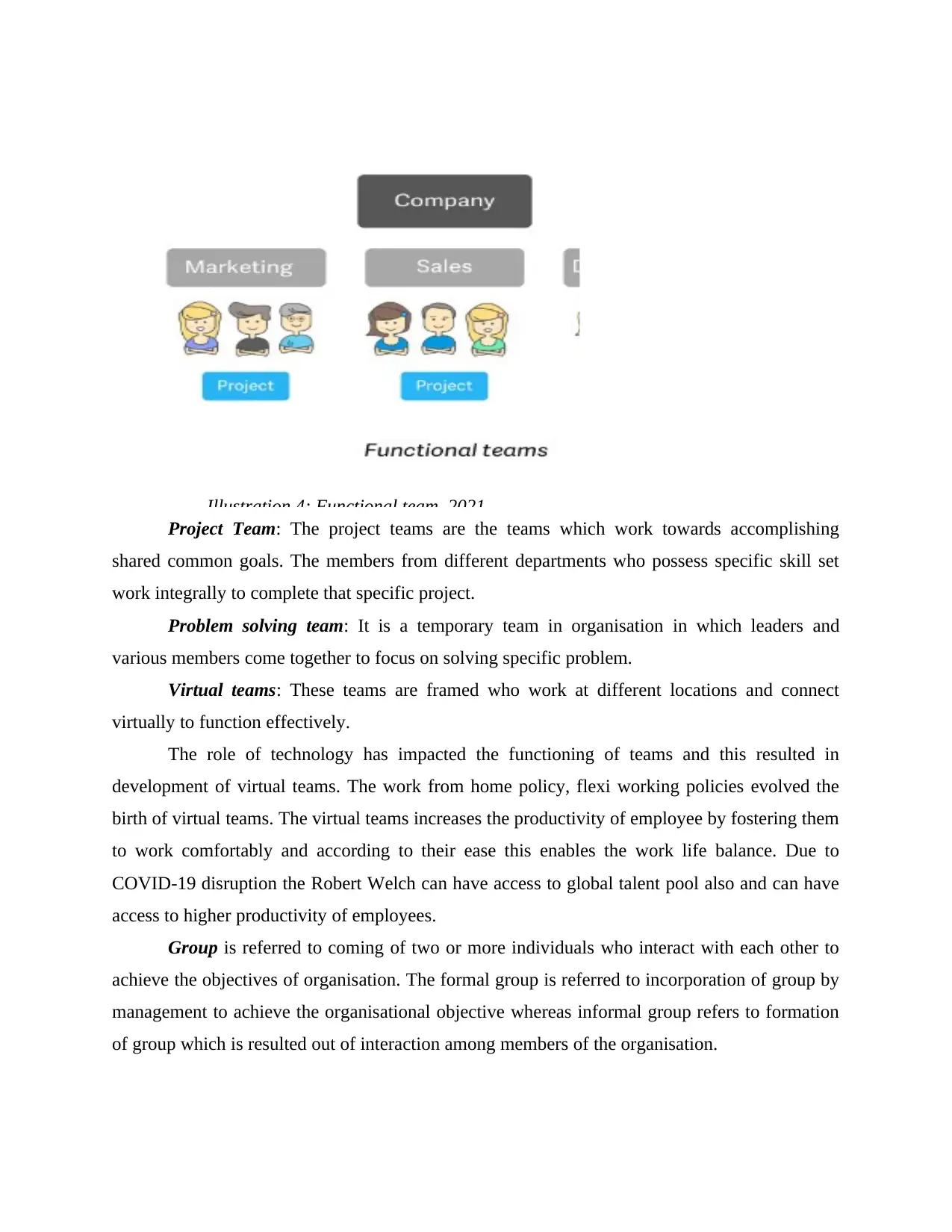
Illustration 4: Functional team, 2021
Project Team: The project teams are the teams which work towards accomplishing
shared common goals. The members from different departments who possess specific skill set
work integrally to complete that specific project.
Problem solving team: It is a temporary team in organisation in which leaders and
various members come together to focus on solving specific problem.
Virtual teams: These teams are framed who work at different locations and connect
virtually to function effectively.
The role of technology has impacted the functioning of teams and this resulted in
development of virtual teams. The work from home policy, flexi working policies evolved the
birth of virtual teams. The virtual teams increases the productivity of employee by fostering them
to work comfortably and according to their ease this enables the work life balance. Due to
COVID-19 disruption the Robert Welch can have access to global talent pool also and can have
access to higher productivity of employees.
Group is referred to coming of two or more individuals who interact with each other to
achieve the objectives of organisation. The formal group is referred to incorporation of group by
management to achieve the organisational objective whereas informal group refers to formation
of group which is resulted out of interaction among members of the organisation.
Project Team: The project teams are the teams which work towards accomplishing
shared common goals. The members from different departments who possess specific skill set
work integrally to complete that specific project.
Problem solving team: It is a temporary team in organisation in which leaders and
various members come together to focus on solving specific problem.
Virtual teams: These teams are framed who work at different locations and connect
virtually to function effectively.
The role of technology has impacted the functioning of teams and this resulted in
development of virtual teams. The work from home policy, flexi working policies evolved the
birth of virtual teams. The virtual teams increases the productivity of employee by fostering them
to work comfortably and according to their ease this enables the work life balance. Due to
COVID-19 disruption the Robert Welch can have access to global talent pool also and can have
access to higher productivity of employees.
Group is referred to coming of two or more individuals who interact with each other to
achieve the objectives of organisation. The formal group is referred to incorporation of group by
management to achieve the organisational objective whereas informal group refers to formation
of group which is resulted out of interaction among members of the organisation.
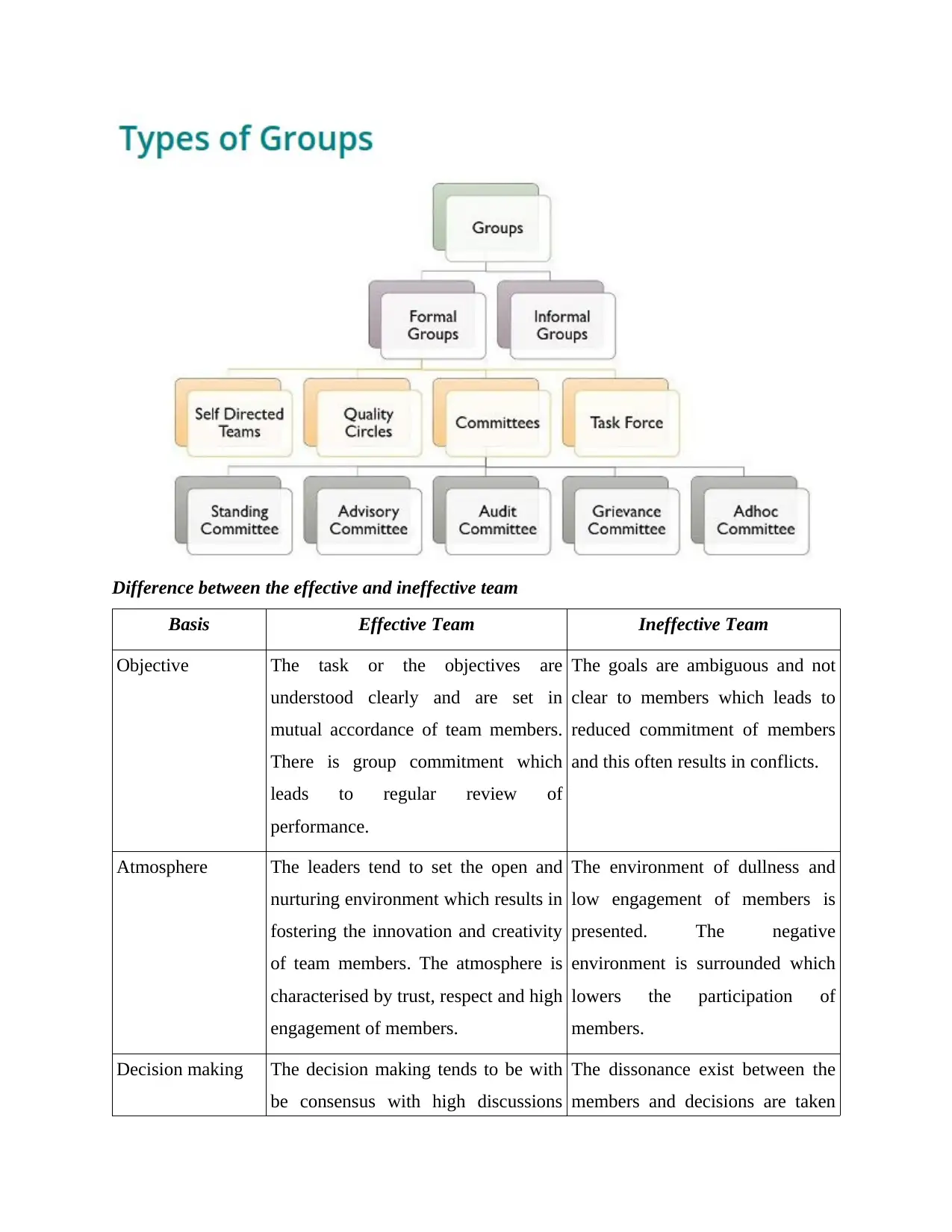
Difference between the effective and ineffective team
Basis Effective Team Ineffective Team
Objective The task or the objectives are
understood clearly and are set in
mutual accordance of team members.
There is group commitment which
leads to regular review of
performance.
The goals are ambiguous and not
clear to members which leads to
reduced commitment of members
and this often results in conflicts.
Atmosphere The leaders tend to set the open and
nurturing environment which results in
fostering the innovation and creativity
of team members. The atmosphere is
characterised by trust, respect and high
engagement of members.
The environment of dullness and
low engagement of members is
presented. The negative
environment is surrounded which
lowers the participation of
members.
Decision making The decision making tends to be with
be consensus with high discussions
The dissonance exist between the
members and decisions are taken
Basis Effective Team Ineffective Team
Objective The task or the objectives are
understood clearly and are set in
mutual accordance of team members.
There is group commitment which
leads to regular review of
performance.
The goals are ambiguous and not
clear to members which leads to
reduced commitment of members
and this often results in conflicts.
Atmosphere The leaders tend to set the open and
nurturing environment which results in
fostering the innovation and creativity
of team members. The atmosphere is
characterised by trust, respect and high
engagement of members.
The environment of dullness and
low engagement of members is
presented. The negative
environment is surrounded which
lowers the participation of
members.
Decision making The decision making tends to be with
be consensus with high discussions
The dissonance exist between the
members and decisions are taken
⊘ This is a preview!⊘
Do you want full access?
Subscribe today to unlock all pages.

Trusted by 1+ million students worldwide
1 out of 18
Related Documents
Your All-in-One AI-Powered Toolkit for Academic Success.
+13062052269
info@desklib.com
Available 24*7 on WhatsApp / Email
![[object Object]](/_next/static/media/star-bottom.7253800d.svg)
Unlock your academic potential
Copyright © 2020–2025 A2Z Services. All Rights Reserved. Developed and managed by ZUCOL.





